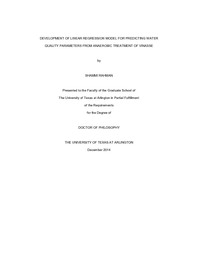| dc.description.abstract | One of the most prominent biofuels today is ethanol. The production of ethanol from biomass, whether from sugar crops, starch crops, dairy products, or cellulosic materials, results in the production of a high-strength liquid waste called vinasse. Approximately 12 liters of vinasse are produced for every 1 liter of ethanol. Vinasse is high in solids and organic content, with biochemical oxygen demand (BOD) ranging from 30 to 40 g/L, and a low pH, typically from 3-5. Traditionally, in countries such as India, Brazil, and other Latin American countries, vinasse has been disposed of by applying it as a fertilizer on agricultural land. This can produce short-term benefits, because the vinasse contains nutrients like potassium, magnesium, and calcium which are needed for crops like sugarcane. However, over the long term, such disposal can cause severe deterioration of soil, surface water and ground water. The research described here increases our knowledge of anaerobic biological treatment of vinasse. Such treatment reduces the vinasse waste strength and produces stabilized residuals that can be used as fertilizer without creating water pollution problems. Satyawali et al. (2007) reviewed the existing status and advances in treatment methods for vinasse, and found that anaerobic treatment was the most attractive primary treatment due to 80% BOD removal. Anaerobic biological treatment of vinasse also produces methane, which can be used as a renewable energy resource. This research explored the behavior of the different compositions of vinasse in an anaerobic environment at three different temperatures (30, 35, and 400C). The primary goals of this research were 1) to develop laboratory scale anaerobic treatments to study the effect of temperature and vinasse composition on waste composition over time, and 2) to develop regression models for predicting water quality parameters as functions of temperature, time, and vinasse composition. Water quality parameters measured included biochemical oxygen demand (BOD), chemical oxygen demand (COD), ammonia-nitrogen, phosphorus, potassium, sulfate, pH, conductivity, total dissolved solids (TDS), total suspended solids (TSS), and volatile suspended solid (VSS) 6-L glass lab-scale reactors were filled with vinasse of 6 different compositions and operated at 3 different mesophilic temperatures (30, 35, 40C). In the experimental design, the primary constituents of environmental interest - chemical oxygen demand (COD), nitrogen (N), phosphorus (P), potassium (K) and sulfur (S) - were varied over the ranges observed in vinasse, as described in the literature Synthetic vinasse was made from glucose, ammonia, phosphoric acid, potassium hydroxide, and calcium sulfate, in various amounts. For our experiments, we also obtained real vinasse from White Energy, Texas and MGP Ingredient, KS.Percent of methane gas and water quality parameters were monitored as functions of time. Chemical oxygen demand was substantially reduced. Little reduction in BOD was observed. No significant changes in ammonia, potassium, or sulfate were observed. COD and BOD followed first-order decay. Statistical Analysis Software (SAS) was used to conduct Multiple Linear Regressions (MLR) on these water quality parameters (COD and BOD). The other water quality parameters did not decrease substantially with time; thus, no regression was performed. | en_US |


